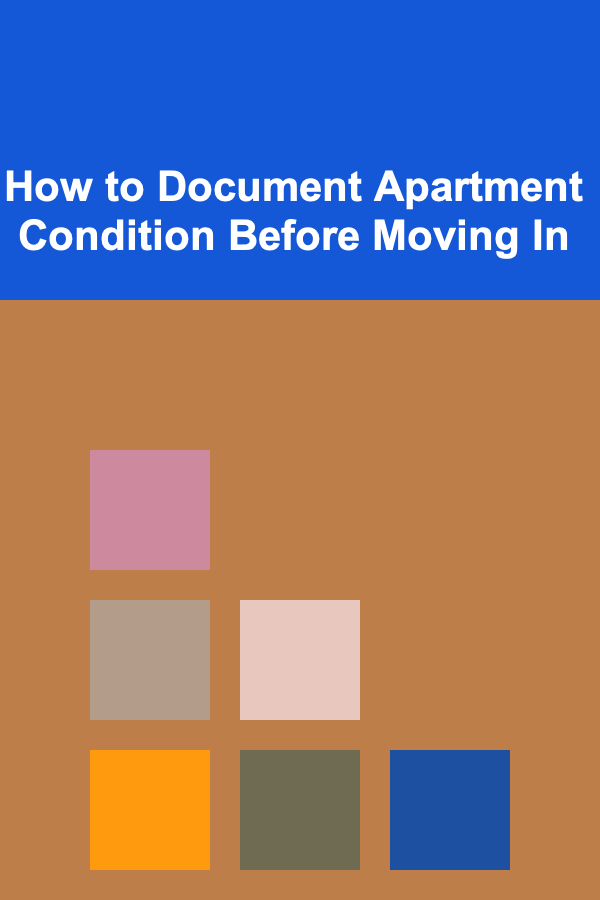
How to Document Apartment Condition Before Moving In
ebook include PDF & Audio bundle (Micro Guide)
$12.99$6.99
Limited Time Offer! Order within the next:

When moving into a new apartment, it's crucial to document the condition of the property. This not only helps avoid disputes when you move out but also ensures that you are not held responsible for any damage that occurred prior to your tenancy. Here's a step-by-step guide on how to effectively document apartment conditions.
Understand the Importance of Documentation
Documenting the condition of your apartment is essential for several reasons:
- Avoid Financial Disputes: If damage is discovered at the end of your lease, you may be held financially responsible for repairs. Clear documentation helps prevent this.
- Protection of Your Security Deposit: Your security deposit can be partially or fully withheld if there are damages beyond normal wear and tear. With proper documentation, you can ensure your deposit is returned in full.
- Legal Protection: If any disputes arise during or after your lease, you'll have evidence to support your claims.
Get the Right Tools
Before you begin, gather the tools you'll need:
- Camera or Smartphone: A camera with good resolution is necessary to capture clear images of any damage. A smartphone will usually suffice, but make sure the camera quality is adequate.
- Notepad or Digital Document: You can use a physical notepad or a digital document (such as a Word document or a note-taking app) to record observations.
- Checklist: A detailed checklist can help ensure that you cover all areas of the apartment.
Perform a Thorough Walkthrough
Start by conducting a comprehensive walkthrough of the apartment. It's best to do this in daylight for better visibility, so you can clearly see the condition of walls, flooring, and other features.
3.1 Inspect Each Room
- Living Room: Look for any scuff marks, stains, or scratches on the walls, floors, and furniture. Check windows for cracks or broken seals. Inspect any built-in shelving, light fixtures, and outlets.
- Kitchen: Inspect appliances (stove, refrigerator, microwave, dishwasher) to ensure they are working properly. Look for signs of wear or damage on countertops, cabinets, and flooring. Make sure faucets and drains are functioning correctly and not leaking.
- Bedroom(s): Examine the floors for any damage, and ensure that walls are free from holes or peeling paint. Check closets, doors, and light fixtures for proper functioning.
- Bathroom(s): Inspect the sink, shower, toilet, and other plumbing fixtures for any signs of leaks, stains, or mold. Make sure there are no cracks in the tiles or flooring, and check the condition of mirrors and lighting.
3.2 Focus on Specific Areas
- Windows and Doors: Check that all windows and doors open and close properly. Look for cracks in window panes, missing or damaged screens, or signs of water damage.
- Electrical Systems: Test all light switches, electrical outlets, and any built-in electronics to ensure they're functioning properly.
- HVAC and Plumbing: Check the heating and air conditioning units. Test faucets and flush toilets to ensure that plumbing is working efficiently.
Take Detailed Photographs
Photographs serve as strong evidence when documenting the condition of your apartment. For each room, take pictures from multiple angles to capture as much detail as possible. Here are some key tips for taking effective photographs:
- Take Close-Up and Wide Shots: For any damage or wear, take close-up shots to show the detail. Then, take wide-angle shots to show the context of the room.
- Document Everything: Include photos of any stains, scratches, holes, or worn areas. Make sure to capture any damage to appliances, walls, and floors.
- Date-Stamp Photos: If possible, use a camera or smartphone that has the capability to automatically date-stamp photos. This will provide a clear timeline for when the photos were taken.
- Capture Serial Numbers: For appliances, take pictures of serial numbers or any identification tags. This can help prove that the items were present and in good condition when you moved in.
Create a Detailed Written Report
In addition to photographs, it's essential to document everything in writing. This report should detail the condition of each area of the apartment and list any damage or issues.
- Describe the Condition of Each Room: For each room, provide a description of what you observed. If there is any pre-existing damage, be specific about the location and extent.
- List Any Repairs or Issues: Document any maintenance issues that need attention. If something is damaged, be clear about what needs to be fixed and its severity.
- Take Note of Missing Items: If anything in the apartment is missing, such as a lightbulb or a curtain rod, make a note of it. This will help prevent misunderstandings later.
Review and Sign a Move-In Inspection Form
Many landlords provide a move-in inspection form that details the condition of the apartment. Review this form carefully and compare it to your own documentation. If there are discrepancies, make sure they are noted on the form before signing it.
- Agree on the Details: If your landlord provides a form with a list of items to inspect, ensure that everything is accounted for, including all furniture and appliances. Compare your observations to the form.
- Ask for a Copy: Once the inspection is complete, request a signed copy of the inspection form from your landlord. This serves as additional documentation for your records.
Keep Your Documentation Safe
After completing the documentation, store all the photographs, written reports, and inspection forms in a safe place. You can create a folder on your computer or in cloud storage to keep everything organized. It's also a good idea to keep a hard copy of the documents, especially the signed move-in inspection form, in case of future disputes.
Follow Up with Your Landlord
After you've completed your documentation, it's a good practice to send a copy to your landlord or property manager. This serves as an official record of the apartment's condition and shows that you've thoroughly documented everything. If there are any issues that require attention, follow up promptly.
- Request Repairs if Necessary: If you discovered maintenance issues or damage, let your landlord know immediately. Be polite but firm in requesting repairs or adjustments.
- Keep Records of Communication: Always keep records of any communication with your landlord. Emails or written letters are preferable to phone calls, as they create a paper trail.
Prepare for the Move-Out Inspection
When you move out of the apartment, the condition will be compared to the move-in inspection report. By keeping your own documentation, you'll be in a strong position to ensure you're not unfairly charged for damage that was pre-existing. Take similar photographs during the move-out inspection to compare with your initial documentation.
- Fix Minor Damage: If there are minor issues that you caused, it's generally a good idea to fix them before you move out. However, don't assume responsibility for pre-existing damage.
- Clean the Apartment Thoroughly: Cleaning your apartment thoroughly before moving out will help avoid disputes related to cleanliness. Ensure that carpets are vacuumed, appliances are wiped down, and bathrooms are spotless.
Conclusion
Properly documenting the condition of your apartment before moving in is an essential step in protecting yourself from potential disputes and ensuring that you receive your security deposit back in full. By following the steps outlined in this guide---conducting a thorough walkthrough, taking detailed photographs, creating a written report, and reviewing the inspection form---you can ensure that you have comprehensive evidence of the apartment's condition. Keeping organized records and maintaining good communication with your landlord will help make your tenancy smoother and more transparent.
By taking the time to document the condition of your apartment carefully, you safeguard yourself legally and financially, helping to ensure a positive rental experience.
Reading More From Our Other Websites
- [Digital Decluttering Tip 101] Digital Minimalism: Reducing Screen Noise and App Overload
- [Home Holiday Decoration 101] How to Decorate a Holiday Mantel Like a Pro
- [Organization Tip 101] How to Use Concrete Stains to Create Unique and Customized Floor Designs
- [Home Staging 101] How to Maximize the Impact of Professional Home Staging Services
- [Whitewater Rafting Tip 101] Essential Rafting Gear: What Every Beginner Needs
- [Home Budget 101] How to Create a Monthly Budget That Works for Your Home Finances
- [Personal Care Tips 101] How to Choose a Sunscreen for Outdoor Activities
- [Home Space Saving 101] How to Maximize Small Living Room Spaces with Smart Furniture
- [Organization Tip 101] Why Organizing Your Finances Leads to Better Budgeting
- [Home Maintenance 101] How to Inspect and Maintain Your Home's Foundation for Cracks

Building a Strong Foundation in Data Analytics for Job Role Success
Read More
How to Achieve Big Results While Saving Money on Home Remodeling Projects
Read More
How to Organize Home Office Spaces for Staging
Read More
How to Score Big Savings with Smart Bargain Hunting
Read More
How to Navigate Psychiatric Medication Management
Read More
How to Secure Your Mobile App from Common Threats
Read MoreOther Products

Building a Strong Foundation in Data Analytics for Job Role Success
Read More
How to Achieve Big Results While Saving Money on Home Remodeling Projects
Read More
How to Organize Home Office Spaces for Staging
Read More
How to Score Big Savings with Smart Bargain Hunting
Read More
How to Navigate Psychiatric Medication Management
Read More